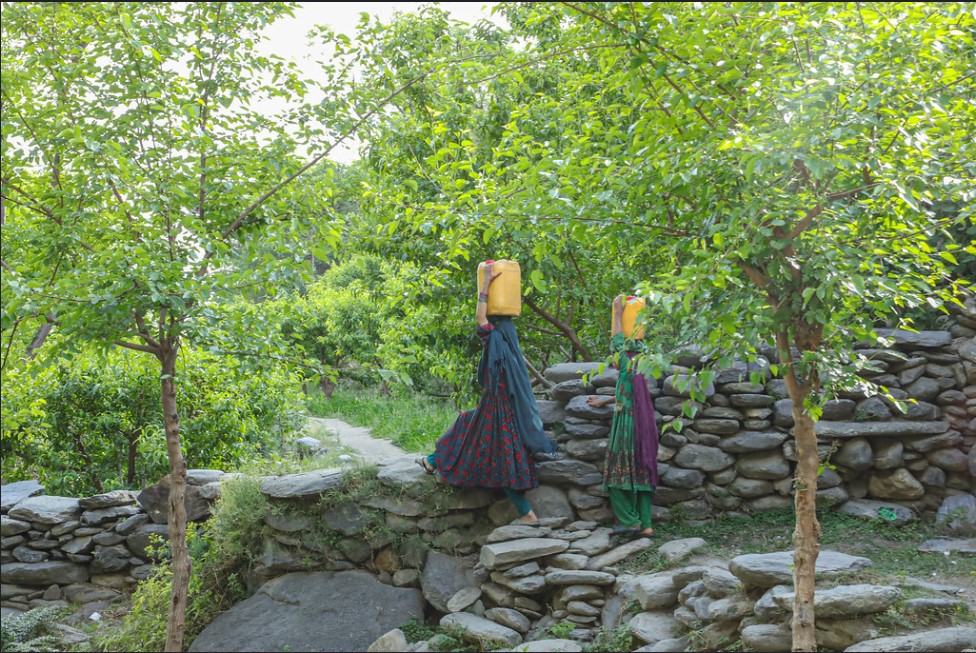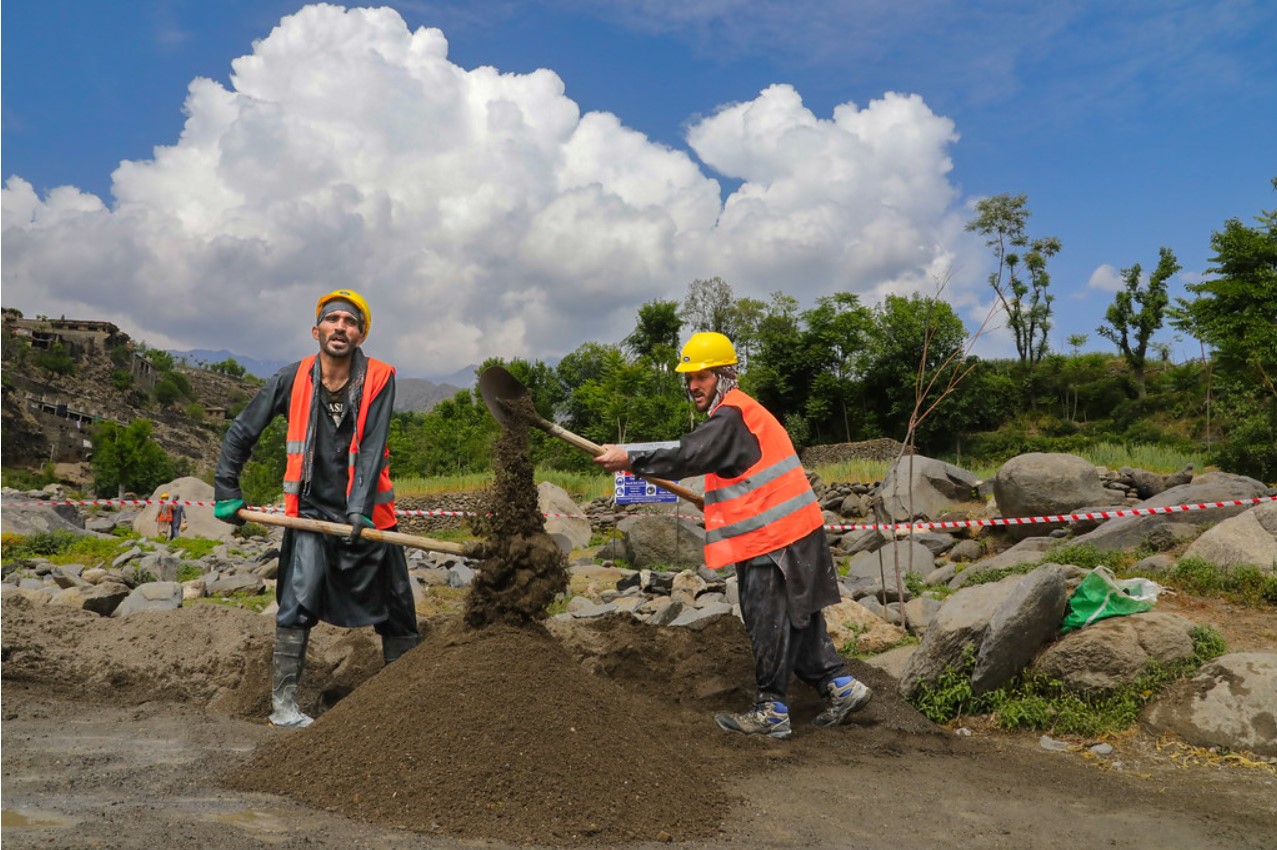How UNDP Afghanistan supports communities to avert the affects of climate crisis
Too much, too little, but never too late
August 23, 2022
Amidst the towering walnut trees, deep in the valleys of the Dara-E-Nur, east of Afghanistan, Jamilah (18) and her sister Razia (15) have been waiting for two and a half hours by one of the only two active springs to fill their 20-liter water barrels.
In the village of Kamah District, Nangarhar, Arman(9) gazes at the construction of a protection wall that is supposed to shield their house and land from floods during the heavy rain seasons.
Both scenes are an alarming reminder of how the climate crisis has changed the everyday scenes to the smallest villages of Afghanistan. A country that contributes one of the lowest greenhouse gases globally – ranks as the 10th most vulnerable country in the world when it comes to climate crisis resilience with poor infrastructure unable to cope with the sudden crisis. It is suffering its second drought in four years, along with an economic meltdown compounding the current humanitarian emergency.
The Dara-E-Nur river, the primary water source in this region that originates from the mountains of the valley, had suffered years of drought, while the underground water levels remain critically low. "Most of the springs have dried up, and without proper infrastructure, the sub-streams are not enough to irrigate our fields," says Jabar Khan, a community elder.
With the worsening climate crisis, the water flows decreased while cases of floods increased. When the flood devastates the valley and its water channels, the agricultural lands suffer without proper water supply for days.
To prepare communities to address challenges related to the climate crisis, UNDP Afghanistan adopted an area-specific, community-inclusive strategy, the Area-based Approach for Socio-Economic Recovery and Community Resilience in Afghanistan, known as the ABADEI Programme.

UNDP Afghanistan with the community built two intakes in the Mena and Ketala villages of Dara-E-Nur. These structures slow down the flood water and help it to supply the substreams of the villages. Intakes are also crucial to recharge the underground water reserves, which reappear as springs.
"The roar of the flood which destroyed several houses and agricultural lands five years ago still rings my ears," said Jabar "since then, the floods became more frequent, but during the farming seasons, the water in the reiver remain low," he added.
For Jabar Khan, completing this project means one of his long-held dreams come true "Agriculture will flourish once again," he said. "I will cultivate all my lands for the next season this year."
Baz Mohammad is a farmer in Katala Village. A flood flushed out all his agricultural products last year, then his second season perished due to water shortage. "I was so depressed seeing my crops perishing, but I am helpless to redirect the water from the river to my lands."
The river bank is lower than the agricultural fields; therefore, extra infrastructure are essential to ensure there is a steady flow of water for the families, agriculture, and livestock.

The Katala and Mena intakes, with a total length of 47 meters, help to supply water to 600 hectares (1121 Football fields) of agricultural land to a total of nine villages. 1,130 families benefit from these two intakes and have better control over the canal water for irrigation and flood protection.
On top of that, the cash-for-work arrangement to build the protection wall will bring additional income to around 200 families in the local communities, alleviating poverty and improving food security.
Mohammad Jan is a farmer with little land. With the drought, he cannot produce enough to even cover his family’s needs. He now has a double income through the project and his farming. "This was a big support for my family," he said. "I can now buy some long-delayed things for my children."
While people are fighting the drought and seasonal flash floods in Dara-E-Nur, residents of the Muslimabad village of Kama District are fed up with the Kunar River overflow. Due to poor infrastructure, the villagers eventually lost control over the water flow of the Kunar river and had to abandon hundreds of hectares of their land.
Muslimabad village is right up against the banks of the Kunar River. Floods are common here, especially between June and September, and can destroy agricultural land and properties. In 2018, a single flood affected 650 houses and 150 hectares of farming lands and those in three surrounding villages.
"It was midnight, and I was fast asleep. Suddenly there was a commotion, and everyone was shouting that the flood was coming," says Arman "when I ran out of the room, there was water everywhere."
That night Arman and his family were rescued by tire tube with the help of nearby villagers. If it was not for the timely support of their villagers, Arman and his family could have lost their lives.
Environmental disasters are so frequent in Afghanistan in the last two decades, affecting 200K people yearly. Communities are not equipped with the systems they need to help them prevent, warn and prepare for a disaster. This means a higher likelihood of loss of lives, land, livelihoods, and infrastructure.
According to Sherwali, head of the Muslimabad council, nobody was able to cultivate their lands. "The river was flowing on our lands, and we could not cultivate them for years," He said, "we have lost many houses, land, livestock, and even people to the floods."
Whether there are too much water, too little water, it is never too late to do something about it. The situation improved after a stone masonry flood wall was constructed by a UNDP-supported project in 2020; however, more had to be done to protect the downstream areas. The communities in the area thus requested an extension of the previous wall. Unlike the stone masonry wall, the extension was a boulder wall, using local materials rather than imported cement. This also meant the wall could be constructed throughout the seasons and erected by even unskilled laborers, providing much-needed income for the local community.
The construction of this 640-meter-long boulder wall now protects 650 families and 150 hectares of agricultural land. Moreover, it reclaimed 50 hectares of farmland and relieved the food insecurity of the villages by increasing their crops, providing short-term employment, and reducing flooding risks.
During the project implementation, 650 local unskilled and skilled laborers received daily wage.
Jamaluddin is a displaced person from Nuristan, another eastern province, who resides in Muslimabad village. He temporarily farms on others' land, but today, he is helping erect the boulder wall. "This job may be short-term, but is a great support to my finances," he said, "there is a lot of competition for those working in agriculture now," he added. He feels fortunate to be selected by the community as a labourer. "I feel proud to be building my country," he continued.
For Haji Mohammad, the ABADEI cash-for-work was the first paid work he got after the sudden political change in August 2021. "I was so stressed and feeling useless," he continues after a deep breath, "I hope more of these projects and job opportunities are provided to the people."
The political change on 15 August 2021 has created new conditions. A socio-economic report of UNDP Afghanistan suggested an economic contraction by 20 percent of GDP within a year and a decline that may reach 30 percent in the following years." UNDP Afghanistan's projections show that poverty may become nearly universal, affecting more than 97 percent of the population by mid-2022.
ABADEI fights poverty and vulnerability by creating immediate sources of income through short-term cash for work jobs. The community’s resilience against climate change is enhanced by rehabilitating small but critical agricultural infrastructure.
Exposure: https://undpafghanistan.exposure.co/climate-change-
Photo Album: https://www.flickr.com/photos/undpafghanistan/albums/72177720300000094

 Locations
Locations



